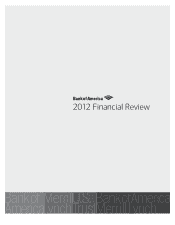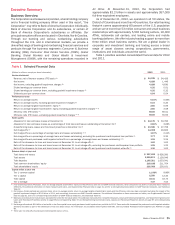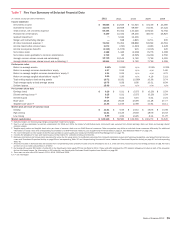Bank of America 2012 Annual Report Download - page 21
Download and view the complete annual report
Please find page 21 of the 2012 Bank of America annual report below. You can navigate through the pages in the report by either clicking on the pages listed below, or by using the keyword search tool below to find specific information within the annual report.Bank of America 2012 19
Management’s Discussion and Analysis of Financial Condition and Results of Operations
This report, the documents that it incorporates by reference and
the documents into which it may be incorporated by reference may
contain, and from time to time Bank of America Corporation
(collectively with its subsidiaries, the Corporation) and its
management may make certain statements that constitute forward-
looking statements within the meaning of the Private Securities
Litigation Reform Act of 1995. These statements can be identified
by the fact that they do not relate strictly to historical or current
facts. Forward-looking statements often use words such as
“expects,” “anticipates,” “believes,” “estimates,” “targets,” “intends,”
“plans,” “goal” and other similar expressions or future or conditional
verbs such as “will,” “may,” “might,” “should,” “would” and “could.” The
forward-looking statements made represent the current
expectations, plans or forecasts of the Corporation regarding the
Corporation’s future results and revenues, and future business and
economic conditions more generally, including statements
concerning: expectations regarding actions to be taken by the
Federal Reserve; transfers of servicing rights scheduled to occur in
stages over the course of 2013 with the delinquent loans scheduled
to be transferred after the current loans; that the criteria for
inclusion in the Legacy Assets & Servicing portfolios will continue
to be evaluated over time; the expectation that approximately $200
million in servicing fees recognized per quarter related to servicing
transferred will decrease throughout 2013 as the servicing is
transferred and that over time the impact on earnings will be
negligible as expenses are expected to also decrease after servicing
is transferred, especially the loans which are 60 days or more past
due; the expectation that liability management actions taken in the
fourth quarter of 2012 will result in pre-tax net interest income
benefit of approximately $350 million in 2013; effects of the FNMA
Settlement and 2013 IFR Acceleration Agreement; the achievement
of cost savings in certain noninterest expense categories as
workflows continue to be streamlined, processes simplified and
expenses aligned with the overall strategic plan and operating
principles; projected New BAC Phase 1 annualized cost savings of
more than $5 billion by the fourth quarter of 2013 with the full
impact expected to be realized in 2014; the expectation that New
BAC Phase 2 will result in an additional $3 billion of annualized cost
savings by mid-2015; that the Corporation may conduct additional
redemptions, tender offers, exercises and other transactions in the
future depending on prevailing market conditions, liquidity,
regulatory and other factors; the expectation that the Corporation
would record a charge to income tax expense of approximately $800
million if the income tax rate were reduced to 21 percent by 2014
as suggested in U.K. Treasury announcements and assuming no
change in the deferred tax asset balance; the goal to manage
interest rate sensitivity so that movements in interest rates do not
significantly adversely affect earnings and capital; that the sale of
the GWIM international wealth management business and the
Japanese brokerage joint venture are not expected to have a
significant impact on the Corporation’s balance sheet, results of
operations or capital ratios; the expectation that the Corporation
will make at least $319 million of contributions to pension plans
during 2013; the expectation that unresolved repurchase claims
related to private-label securitization trustees and third-party
securitization sponsors will continue to increase; the resolution of
representations and warranties repurchase and other claims; the
final resolution of the BNY Mellon Settlement; the estimates of
liability and range of possible loss for representations and
warranties repurchase claims; the possibility that future
representations and warranties losses may occur in excess of the
amounts recorded for those exposures; that the expiration and
mutual non-renewal of certain contractual delivery commitments
and variances with Fannie Mae will not have a material impact on
our CRES business, as the Corporation expects to rely on other
sources of liquidity to actively extend mortgage credit to customers
including continuing to deliver such products into Freddie Mac
mortgage-backed securities pools; that there will likely be additional
requests from monolines for loan files in the future leading to
repurchase claims; the belief that increases in requests for loan
files from certain private-label securitization trustees and requests
for tolling agreements to toll the applicable statutes of limitation
related to representations and warranties repurchase claims will
likely lead to an increase in repurchase claims from private-label
securitization trustees with standing to bring such claims; the
disposition and resolution of servicing matters; that implementation
of uniform servicing standards is expected to contribute to elevated
costs associated with the servicing process but is not expected to
result in material delays or dislocation in the performance of the
mortgage servicing obligations including the completion of
foreclosures; beliefs and expectations concerning the impact of the
National Mortgage Settlement; the Corporation’s belief that the
decline in default-related servicing costs will continue to accelerate
in 2013; that swap dealers will continue to become subject to
additional CFTC rules as and when such rules take effect; that the
proposed rule regarding credit risk retention would likely have an
adverse impact on the Corporation’s ability to engage in many types
of the MBS and ABS securitizations conducted in CRES, Global
Markets and other business segments, impose additional
operational and compliance costs and negatively influence the
value, liquidity and transferability of ABS or MBS, loans and other
assets; that the Dodd-Frank Wall Street Reform and Consumer
Protection Act (Financial Reform Act) will continue to have a
significant and negative impact on earnings through fee reductions,
higher costs and new restrictions as well as reductions to available
capital; the substance and timing of the final rules implementing
Basel 3; the expectation that the Corporation will comply with the
final Basel 3 rules when issued and effective; that estimates under
the Basel 3 Advanced Approach will be refined over time as a result
of further rulemaking or clarification by U.S. banking regulators and
as its understanding and interpretation of the rules evolve; that the
final rules when adopted and fully implemented are likely to
influence regulatory capital and liquidity planning processes and
may impose additional operational and compliance costs on the
Corporation; the expectation that the Liquidity Coverage Ratio
requirement will be implemented in January 2015 and the Net
Stable Funding Ratio requirement in January 2018, following an
observation period that began in 2011; the goal to seek to maintain
safety and soundness at all times, including under adverse
conditions, to take advantage of organic growth opportunities,
maintain ready access to financial markets, continue to serve as a
credit intermediary, remain a source of strength for the Corporation’s
subsidiaries, and satisfy current and future regulatory capital
requirements; the goal of mitigating refinancing risk by actively
managing the amount of borrowings that will likely mature within
any month or quarter; the objective of maintaining high-quality credit
ratings; that, if the Corporation’s analytical models for capital
measurement under Basel 3 are not approved by the U.S. regulatory
























